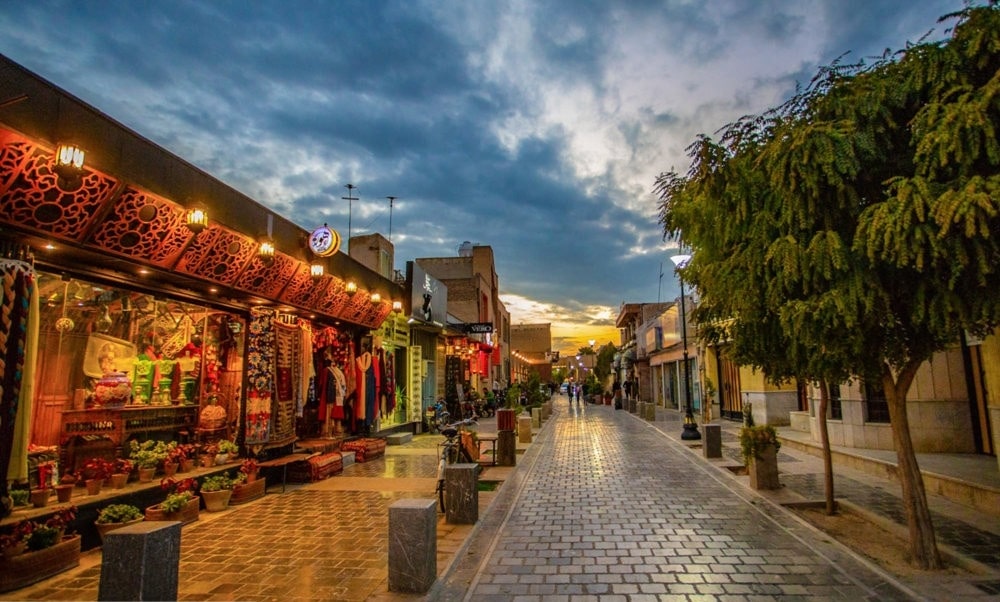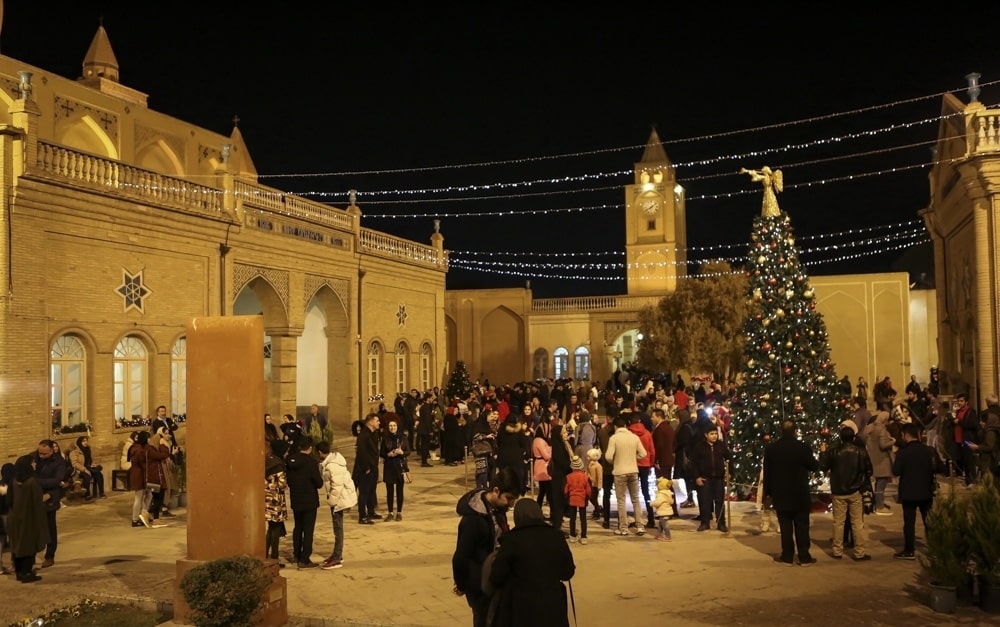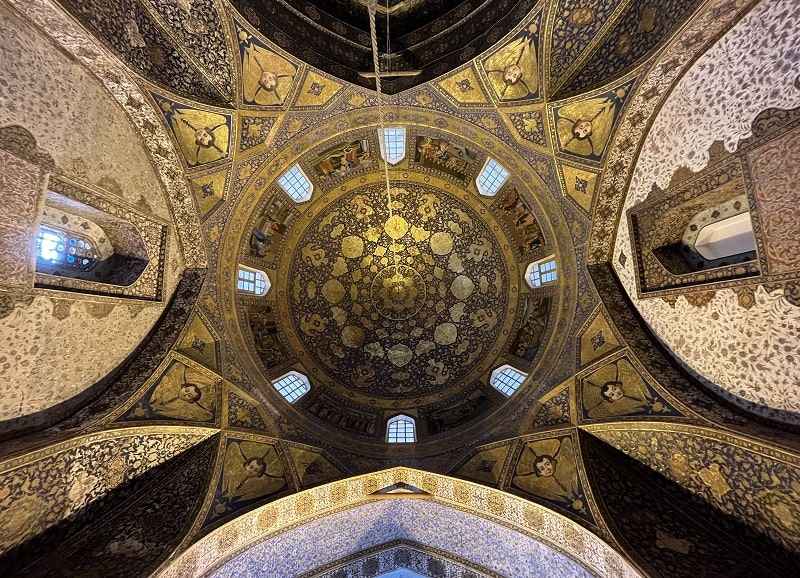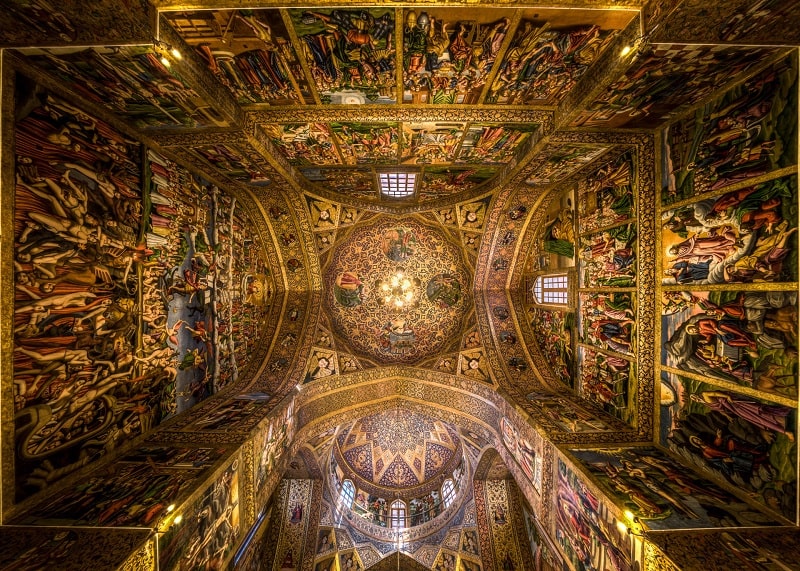Introduction to Julfa
Somewhere in the bustle of the thriving and stunning bazaar in Hakim Nezam and Nazar Streets, there is an old neighborhood containing an ancient history and a significant name. To begin any journey in Isfahan, we must look back to the Safavid era, when Shah Abbas I was competing with his old rival, the Ottoman ruler. Julfa or Jolfa, a city in present-day Nakhchivan, where is now part of Azerbaijan, is the starting point of this story. By order of Shah Abbas I, the city inhabitants had to leave their homes and homeland to provide their security against the Armenian genocide. Historical documents reveal that the people evacuated the city within three days by the king’s order. A long journey began in 1633; The tough winter passed during the migration, with the beginning of spring, the people of Jolfa settled in Isfahan, and Chaharmahal and Bakhtiari. Around 3000 families moved to Isfahan and around it.

Old Julfa (Jolfa)
To show his goodwill, the king granted lands to the forced travelers of Isfahan on the Zayandeh-Rud River’s ridges. The story is the beginning of the nearly 400 years old neighborhood, Julfa, in Isfahan. Immigrant Armenians named the region Julfa (Jugha) in memory of their original homeland. Gradually, the constructions started, and of course, Shah Abbas I’s kindness caused other Armenians to choose this city. The houses’ architecture was in Armenians’ style, but with domestic materials in Isfahan!
There was a street from east to west, where the famous family of Khwaja Sarafrazian lived at the western end, and the Yamaniyan family at the eastern, thus the western gate became known as Sarafrazian and the eastern gate as Yamaniyan. The construction began when the space in between was divided into ten areas. The first structures architectured following houses were churches that gave the area a Christian spirit. Several baths, a large bazaar, and two caravanserais next to a quadrangle square were other structures of the Armenian neighborhood, providing Julfa an enchanting comfortable city.
The Armenian cemetery, where is now a full-fledged museum, was also located at the end of the town. Armenians were skilled and artisan people; Weaving, jewelry and gold design made them capable people. Five neighborhoods of Meydan-e Bozorg (Grand Square in Farsi), Meydan-e Kuchak (Small Square in Farsi), Chaharsoo, Gharagel or Qarakel, and Hakopjan were formed Old Julfa with a specific scheme during the reign of Shah Abbas I. The Armenians, who specialized in fine handicrafts, stone carving and trade, quickly became rich and built more churches.
New Julfa
Two other neighborhoods, inhabited by Irvani and Tabrizi people, were added to this town during the reign of Shah Abbas II, half a century after the migration, with the increase of the Armenian population living in the Jolfa neighborhood; the number of town parts reached seven. The new quarters of the city were called New Julfa. Now, all the Esfahansi inhabitants knew the area’s stonemasons well, also the sound of church bells is part of Isfahan beside the Adhan (Islamic call to prayer).
Armenians had a vast influence on the country’s development in those days; For instance, the printing press was first brought to Persia by Khachatur Kesaratsi, the Armenian caliph, whose memorial statue is in one of the Julfa districts. Years have passed, only two neighborhoods, the Yerevanian and the Tabrizi’s are still Armenian, and many Muslims live in the rest of Julfa. There is an intimacy between Armenians and Muslims worth more than all the wealth; perhaps the differences and sincerity are the valuable features that have made Iran so desirable and enchanting. The neighborhood, where looks like a privileged town in the heart of the glamorous city of Isfahan, embraces old paving stones, almost intact and pure architecture as well.

Saint Mary Church
Although the Armenians built the Surp Hakop or Hagop Church since their arrival, the church’s capacity was not responsive to the Armenian population. So Avedik Babakian, a well-known Armenian silk merchant, built St. Mary or St. Mary the Virgin’s Church next to it, where he is buried. The astonishing paintings, the church hall’s stunning dome, and the Persian tiling are mind-blowing. These two churches are the first and second churches in Isfahan, built during the reign of Shah Abbas I, now located in Julfa Square.
The Holy Bethlehem Church or Bedkhem Church
There is a church with a high status near Saint Mary Church in Jolfa Square. A monument from the Safavid era, founded by Khajeh Petros. Iranian and Armenian masters have joined together and created astonishments. Exquisite paintings beside attractive Persian seven-coloured tiles have made Bethlehem an immortal construction. Khaje Petros and his family rest in this church.

Vank Cathedral or the Church of the Saintly Sisters
You must have heard the name of this church many times. A church belonging to 1655, which the Armenians call Āmenāperkič (meaning the Holy Savior). A brick church with an all-Persian dome with a clock tower and bells that you can see from a distance. The church’s inside will amaze you; Like European churches full of delicate astonishing paintings representing the life of Jesus Christ from birth to ascension. Heaven and Hell beside Bible verses are other embellishing visions of Vank Church. The church was constructed at the personal expense of a wealthy Armenian named Khajeh Avedik Stepanos, painted by Armenian artists. The golden decorations of the church are also universally famous.

Jolfa Neighborhood in terms of Architecture
Entering the Jolfa neighborhood, the streets and alleys’ pavings will catch your eye. The distinction is obvious even beside the modern buildings of today. Jolfa Square is like a natural museum embracing old and small vendors and shops that you cannot believe that their doors will be open in the morning. These small shops have now become an attraction in Julfa Square. The high clocks and church bells are the hallmarks of the area, some old dwellings still stand, and sometimes Armenian inscriptions on the houses bring attention. Vases adorn cafes and alleys, but among all the Julfa sights, the thousand-colour cafes in the region stand out. Julfa cafes have European design and appearance whose wood smells are delightful. The chic boutiques and shops make Julfa such a youthful neighborhood that also justifies the presence of so many cafes and restaurants.
Sculptures with a Christian appearance and the interesting conversation of the Armenians in the language of their ancestors will thoroughly take you out of the space a few alleys beyond Esfahan, drown you in Julfa. Be sure to invite yourself to a superior coffee in the back alleys because the smell of Jolfa coffees is intoxicating. Like Firooz Cafe, which from the way it sets its lovely wooden chairs and tables to the small and large antiques that fill the entire cafe, taking you to fascinating historical depths with all kinds of fare.
The old twisted alleys of Julfa with tall trees are eye-catching. Several churches, captivating museums of Armenian art, cafes, baths, and historic houses formed the Julfa historical monuments, along with various stores, music schools, and its particular tranquility have made Julfa a perfect destination. Julfa can be called the most romantic town of Esfahan. The liveliness of Julfa changes with the arrival of the Christian New Year; The smell of Armenian sweets, decorated pines, and adorned alleys change Julfa’s sight. The Santa Clauses and the embellished pines bring enthusiasm to the streets every year. Khaghani Street, one of the prominent streets of Esfahan and this neighborhood, is the centre of Art Galleries and Clothing Commercial Complexes. The masonry alley is on this street, narrating a fascinating world itself.


